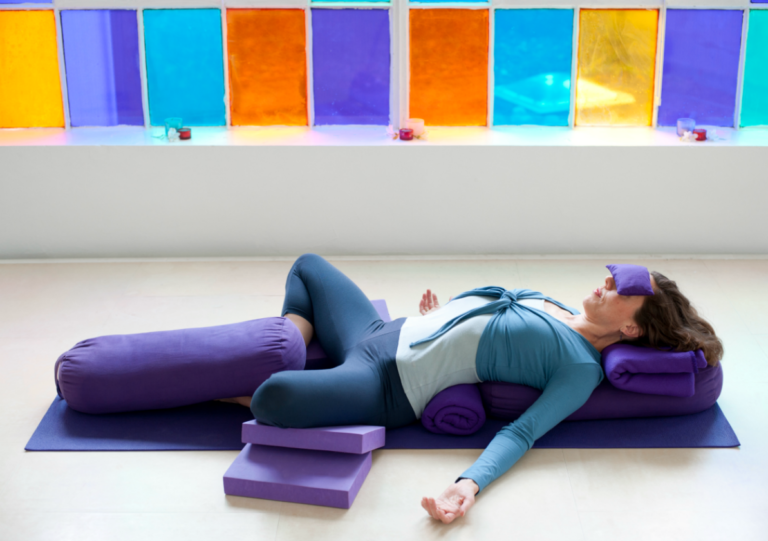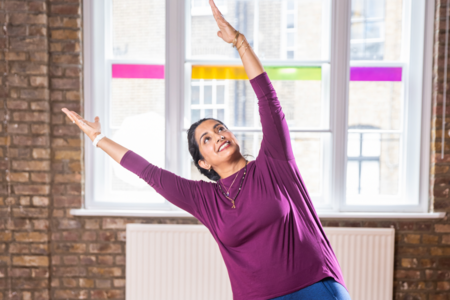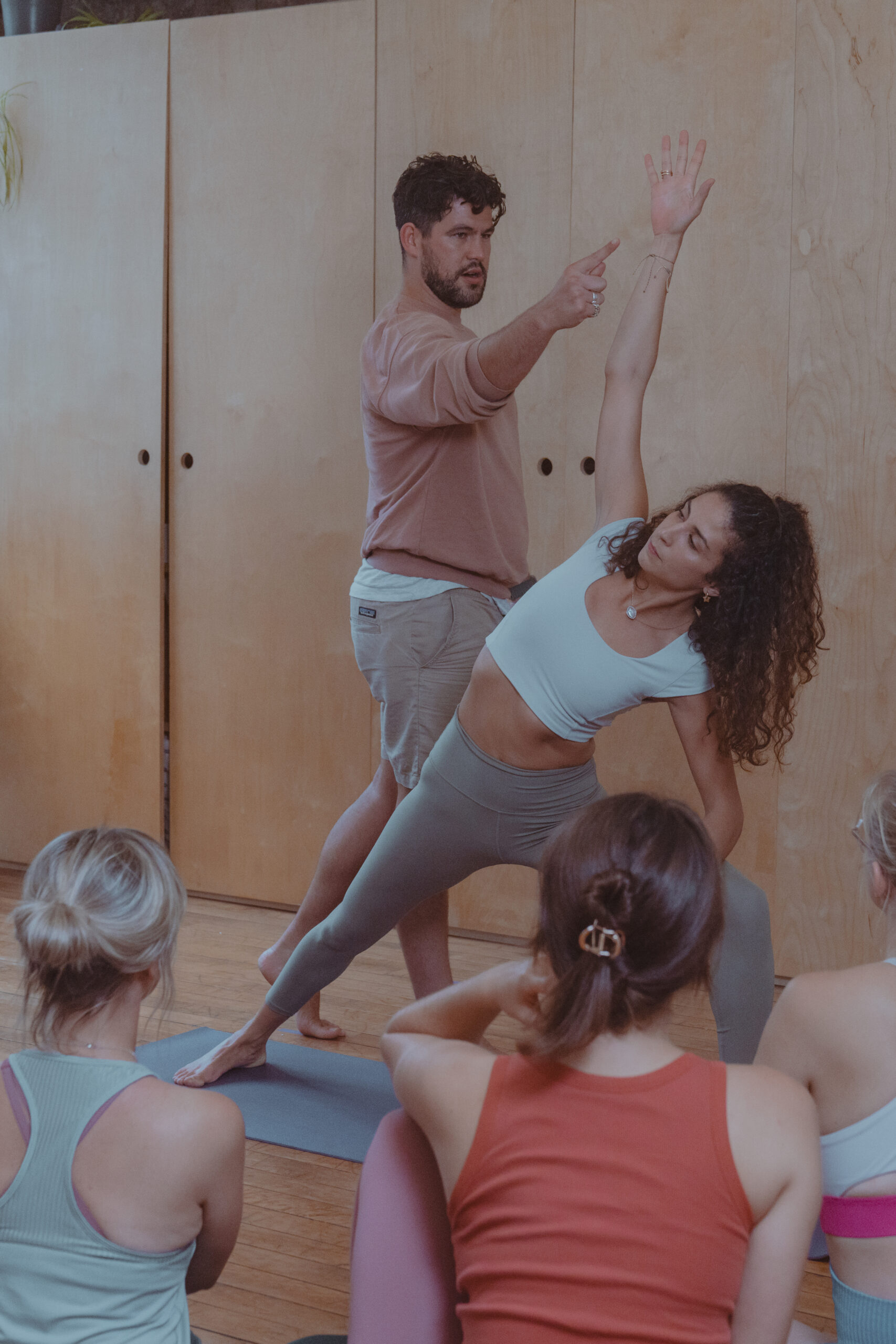Ahead of her online restorative yoga workshop – the well of soul: restorative mini-retreat – Anna Ashby shares five reasons for practising restorative regardless of what style, lineage or experience you may have.
In a world that has quickly become ‘dangerous’ in ways we could never have imagined a year ago, a style of yoga practice that has been around for awhile hiding behind its more flashy counterparts may be just the thing in a time of pandemic.
Restorative yoga seemed to find its calling under the scrupulous attention of B.K.S. Iyengar, the 20th century master yoga teacher who developed and promulgated yoga ‘props’ as they’ve come to be known in yoga studios far and wide throughout the world.
For many props may appear to be a foreign species looked at with trepidation during a fast and furious yoga practice – “What the…I’m not using these!” – the use of a prop perhaps seen as a necessity for those with less ability or agility.
While a prop such as a block or brick may be a godsend for those who struggle for many different reasons in a yoga class, it’s time to set archaic and erroneous perceptions aside particularly within the context of a restorative yoga class which uses a fair few props!
They can become a delicious and ecstatic means for gliding into a profoundly relaxed state of being (increasingly a distant memory for many!), and a means for embracing the more elevated purpose of yoga practice itself – to know one’s self both in form and beyond form.
To help shift the narrative with regards to restorative yoga, here are five reasons to practise it regardless of what style, lineage or experience you may have.
1 – Nervous system health… er… ?!
Especially in recent times, health for many has become a gift and a priority whether as a preventative or as recovery. We all understand to a certain extent what it means to be healthy, which usually includes eating the right foods and getting enough sleep. But what about nervous system health? Not something that has been emphasised so much in our ‘fast-paced’ culture with its need for speed and stimulation. Add to this the new reality of living in close proximity with a deadly pathogen with no apparent end in sight, and we’ve got a nervous system problem on our hands.
Health becomes compromised when the immune system is compromised; for many this happens when life presents circumstances which shift the nervous system into ‘survival mode’ in a way that is ongoing.
Our nervous system has evolved to keep us alive, and so when circumstances warrant it a whole alchemical process of perception and hormone occurs which shifts the body into survival mode as a response to ‘perceived’ danger. And this takes energy. Lots of it! Other important bodily processes that maintain health and vitality are shut down in order to redirect energy towards supporting a nervous system response that helps us to survive.
Consider if that perceived danger is a pesky pathogen silent yet dangerously present. Or a job furlough or loss where income ceases and bills stack up. We all know the feel of panic and anxiousness when faced with these kind of events which to the nervous system present a huge functional shift of metabolism (whether real or imagined as it doesn’t discriminate prioritising survival).
Chronic low grade stress can result in a a systems break down physically and mentally. Statistics consistently show stress is one of the number one causes of long term illness around the world. The body is simply not designed to maintain this level of nervous system response.
Restorative yoga dampens the nervous system ‘survival’ response promoting relaxation which effectively shifts the metabolism to ‘rest and digest’ and rejuvenation bringing about balance, a increased sense of well-being and vitality which supports immune system function.
2 – Slow down and enjoy your life
Perhaps it was something inculcated at birth – a work ethic that essentially said if you do nothing, you are lazy. How many yoga practitioners still feel at some level that savāsana, the relaxation pose at the end of class, is somehow indulgent? How many teachers cut short savāsana, somehow uncomfortable with stillness and silence? How many students whether in person or on Zoom, leave before savāsana begins? And so how many teachers play music or talk throughout savāsana (or even the whole class?!) in order to push away the discomfort of stillness which reveals the gift of what is present? And so teachers may be inadvertently enabling their students to avoid space and stillness because of the tendency to avoid discomfort.
We are at risk of losing the skill to ‘slow down and smell the roses’ and attend to the smaller details and nuance of a life lived in full awareness and experience of each moment – such is the nature of modern times where technology can complicate the beauty of simplicity and space. Ironically, the pandemic has allowed for some to re-discover this aspect of life.
Restorative yoga allows for the possibility to recalibrate our awareness so that stillness, silence and space become a tonic for living and experiencing a meaningful and rich life.
3 – Release the pattern of holding…
To lie down in a supported way where the body can soften into a sense of being held as is taught in a typical restorative class, what first becomes acutely apparent is tension. To understand the pattern of holding becomes an interesting deep dive into the way life has imprinted onto our organism – whether it be through physical holding patterns or mental and emotional one’s.
Inevitably what is held must be let go, particularly in the context of yoga. So perhaps this aspect of slowing down and becoming still that is so much part of the culture of yoga and particularly restorative yoga, challenges and reveals all the little and large ways we have become frozen – stuck in a pattern that doesn’t allow for softening, opening and connection.
To lie down and be supported engenders a way of being that is inclusive and allows for a sense of moving towards support and connection.
Restorative yoga reveals the pattern of holding, blocking or bracing that in time can be softened and released which asks for a new way of being that reflects inter-connection, respect and mutual relationship.
4 – Breathe and awaken!
In the beginning, the middle and the end – our first inhale gives way to the scream of entry, the exchange of breaths over a lifetime both ordinary and extraordinary, and the final exhale a journey back from whence we’ve come… a mystery – the cycle of life expressed. Breath embodies the most profound and simultaneously ordinary aspect of living and the elusive underpinning of all practices within yoga.
To know the breath intimately is to explore the very essence of life lived. To explore one’s own breath as teacher and constant companion offers steadiness in the ever changing sands of life.
The basic focus of all restorative practice, breath allows us to feel our way back into the very essence of all that we are. And it so happens (of course) that breath is directly hardwired into the nervous system itself – the inhale to that part which awakens and the exhale to that part which calms, both aspects like the wings of a birds flowing in a harmony that allows for a soaring flight.
Restorative yoga develops a profound and meaningful relationship with the breath that serves as teacher and friend over a lifetime. The breathe becomes the means to check in, tune the nervous system and discover a natural exchange that expresses the very foundation of life itself – a giving and a receiving.
5 – Rest properly and feel human!
How often do we settle down and glide into sleep – a deep and restful one – where upon waking there is a joy and vigour to embrace a new day? Because of the complexity of our time which teeters on the cusp of chaos and the insidious nature of stress, good sleep has become as elusive as the Nightingale.
By engaging in restorative practices which allow for nervous system health, we can learn how to prioritise relaxation, give space and time for the body to re-balance and in so doing bring about the conditions for a restful sleep that can restore faith in the goodness, beauty and kindness of humanity.
Restorative yoga creates the conditions for nourishing sleep that give rise to the ability to behold Beauty – to connect and feel an integral part of a balanced and conscious life.
So the question becomes why don’t we practice in this way every day for the sake of a life that holds meaning, purpose and where we can thrive?! It doesn’t take long to experience the down-shift of the nervous system which this way of practicing yoga supports.
I find these words by Jean-Pierre Weill from his children’s book ‘The Well of Being’ inspiring:
“I don’t say there isn’t much work to do, for there is.
And some tracks lead to excruciating darkness, where a person can tumble from the sky on a clear September morning.
Yet is the world not whole? Is it not beautiful?
For now, let’s consider well-being a choice, something you can try on and wear. When we put on the hat and coat of well-being we incline towards joy without special occasion.”
Click here for more information on Anna’s workshop ‘the well of soul: restorative mini-retreat’ taking place on Saturday, 29th August 2020. Not able to make the live stream? Not to worry – the price of the workshop includes access to the online recording for 72 hours.










